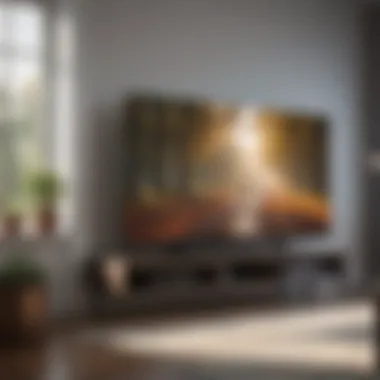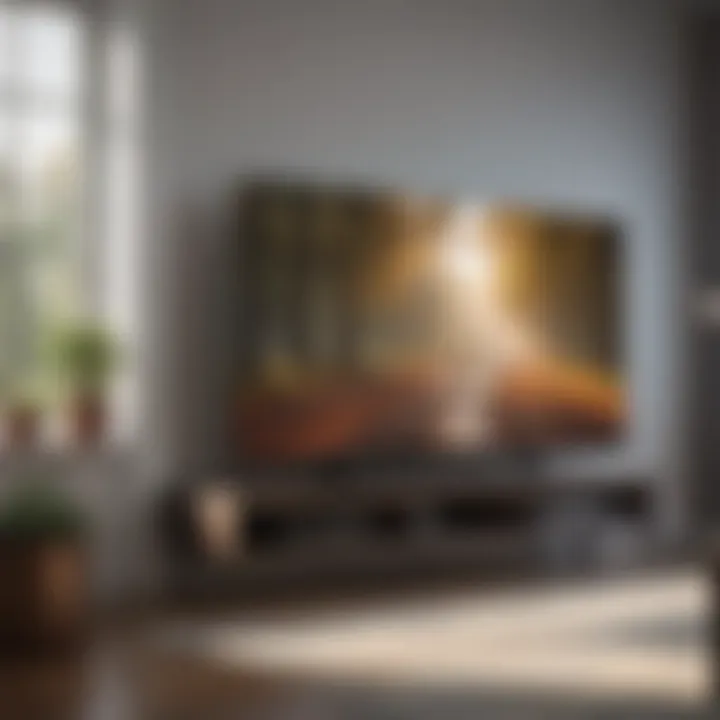Expert Tips for Cleaning Your Big Screen TV


Intro
Maintaining the clarity and aesthetics of your big screen TV is crucial for an optimal viewing experience. With the right techniques and materials, cleaning this important piece of electronic equipment can be straightforward. In this guide, we will provide an in-depth discussion on how to clean your television effectively while preventing damage to its delicate parts. The information herein is tailored for those who value both functionality and presentation of their devices.
Understanding the Importance of Cleaning
Cleaning your big screen TV is more than just a chore. Dust, fingerprints, and grime can accumulate and obscure the image quality. Regular maintenance ensures a longer lifespan for your device and retains the visual experience that these screens are designed to deliver. The right cleaning methods reduce the risk of scratching and other potential damage, which is essential given the sensitive nature of flat panel displays.
This guide will also emphasize common pitfalls, suggest appropriate cleaning products, and help define how often you should engage in this necessary task. By following the outlined practices, you will safeguard your investment while enjoying vivid, clear images on your screen.
Understanding Big Screen TVs
Understanding the types of big screen TVs is crucial for proper maintenance. Each technology—whether it be LED, OLED, QLED, or LCD—has unique traits that influence how they should be cleaned. Knowing these differences helps ensure the cleaning methods preserve the quality of the display while avoiding damage.
Types of Big Screen TVs
LED
LED TVs are popular due to their energy efficiency and brightness. They use light-emitting diodes to illuminate the screen, which can produce a vibrant picture. One key characteristic is their brightness level, making them suitable for well-lit rooms. LED displays can also be fairly affordable, appealing to many consumers. The bright illuminations can sometimes make smudges more noticeable, thereby necessitating regular cleaning to maintain picture clarity.
OLED
OLED technology offers superior picture quality because each pixel emits its own light. This leads to deeper blacks and enhanced contrast. The unique feature of OLED is its flexibility, allowing for thinner screens. However, OLEDs can be more delicate than their LED counterparts, requiring gentler cleaning techniques. Users must avoid harsh chemicals that could damage the screen's surface against potential permanent image retention.
QLED
QLED TVs employ quantum dots to enhance light and color. This technology combines the brightness benefits of LED with richer color output. A distinguishing aspect of QLED is its resistance to burn-in, setting it apart as a more durable option. Regular cleaning is still necessary, but it's often less critical than with OLED. The protective coating on QLED screens can simplify the cleaning process, allowing for a straightforward maintenance routine.
LCD screens, commonly found, work using a liquid crystal display. The strength of LCD resides in its versatility and affordability. These screens are generally more scratch-resistant, but they can attract dust more easily. Cleaning them requires caution to avoid scratches. Moreover, user should always employ the right materials as wrong ones may lead to permanent damage.
Common Issues with Screen Cleanliness
Screen Smudges
Screen smudges occur from day-to-day usage and can obscure viewing pleasure. Oils from fingers or absorptions from nearby surfaces contribute to this issue. Although they may seem minor, screen smudges disrupt clear imaging. Regular cleaning can mitigate this, providing a clearer viewing experience. Using appropriate materials and solutions can effectively remove them without damaging the screen.
Static Dust Accumulation
Static dust tends to accumulate on screens, causing an uneven viewing experience. Dust can carry allergens, affecting household air quality. Additionally, the presence of dust can cause noticeable surface glare when viewing in bright settings. Using a microfiber cloth can help remove dust effectively without scratching the screen. It's essential to clean screens frequently to prevent dust build-up and maintain overall viewing clarity.
Fingerprints and Grease
Fingerprints and grease marks are particularly bothersome on big screen TVs, particularly those with high brightness. They can be triggered by various contaminants, such as food or body oils. Removal is essential to improve the viewing experience. Users should be cautious not to scrub too hard, as excessive pressure may damage the screen. Employing appropriate cleaning solutions and soft cloths will aid in effectively and safely eliminating these marks.
Benefits of Regular Cleaning
Regular cleaning of your big screen TV is essential for several reasons that go beyond mere aesthetics. Keeping the screen clean enhances the overall viewing experience and contributes to the longevity of the device. Each advantage plays a significant role in maintaining the TV's condition and functionality over time.
Enhancing Picture Quality
The clarity of the picture you see on your TV is greatly impacted by the cleanliness of the screen. Dust, fingerprints, and smudges can obscure the vibrant colors and sharp details that modern televisions offer. When you regularly clean your TV, you ensure that the light emitted from the screen is not obstructed. This leads to an uninterrupted viewing experience. A clear screen enhances contrast and brightness, making your favorite shows, movies, and games visually impressive. By maintaining picture clarity, you can appreciate the cinematic quality that high-definition TVs provide.
Extending TV Lifespan
Regular maintenance of your TV through cleaning can significantly extend its lifespan. Dust and debris can accumulate within the screen frame, potentially leading to overheating. Overheating can damage internal components, ultimately reducing the device's functionality. By eliminating these particles through routine cleaning, you create an environment that promotes efficient operation. In turn, this also means fewer repairs or replacements over time, making it a smart investment in your television's future.
Improving Aesthetic Appeal


A clean big screen TV can make a notable difference in the overall appearance of your living space. Dusty screens not only distract from the viewing experience but also create an impression of neglect. Conversely, a well-maintained TV can enhance the aesthetic value of the room. When inviting guests or simply enjoying a night in, a spotless screen reflects a level of care that is visually appealing. A clean TV complements other design elements in your home, contributing to a polished and sophisticated environment.
"The right care and cleaning can transform your viewing experience significantly."
In summary, maintaining a regular cleaning routine offers numerous benefits for both performance and aesthetic aspects of your big screen TV. By understanding these advantages, you are equipped to enjoy a clear, functional, and beautiful television for years to come.
Essential Cleaning Materials
Cleaning a big screen TV is not just about using any cloth or solution. It involves careful consideration of the materials used, impacting both the effectiveness of the cleaning process and the safety of the screen. The right cleaning materials prevent scratches, reduce static, and enhance clarity. Using proper tools ensures the longevity of the device while providing a better viewing experience. Here is a look at the essential cleaning materials you should have on hand.
Microfiber Cloths
Microfiber cloths are an essential cleaning material for big screen TVs. They are designed to trap dust and dirt effectively without scratching the delicate surface of the screen. The fine fibers can remove fingerprints and smudges without the need for excessive pressure. This is crucial, as applying too much force can damage the screen.
Another advantage of microfiber cloths is their reusability. They can be washed and used again, making them a more sustainable option compared to single-use wipes. Additionally, these cloths do not leave lint behind, which is often a concern with traditional cleaning cloths. Therefore, deploying microfiber cloths can significantly enhance your screen cleaning routine.
Cleaning Solutions
Water-based Solutions
Water-based cleaning solutions are favored for their mildness. They typically do not contain harsh chemicals, which means they are safer for sensitive screens. The key characteristic of water-based solutions is that they do not leave harmful residues that could damage the display over time. This makes them a popular choice for regular maintenance.
A unique feature of water-based solutions is their non-toxic nature, making them safe to use around pets and children. However, it is essential to ensure that they are applied sparingly; excess moisture can seep into the TV's edges and cause damage. Thus, when using water-based solutions, a light application with a microfiber cloth is ideal.
Alcohol-free Wipes
Alcohol-free wipes are another practical cleaning choice for big screen TVs. They are effective in removing oils and grease without risking damage to the screen. What’s more, these wipes are convenient for quick cleanups, allowing users to maintain their devices with minimal effort.
A standout feature of alcohol-free wipes is their ability to sanitize the screen without the harshness of alcohol. This makes them suitable for households with sensitive individuals. However, users should be mindful, as some wipes may contain other chemicals that could potentially leave residues. It is best to choose wipes specifically labeled for electronics to ensure their safety.
Avoiding Harmful Products
Abrasive Cleaners
Using abrasive cleaners may be tempting due to their strong formulations, but they are detrimental to big screen TVs. Abrasive materials can scratch the surface, which in turn reduces the quality of the display. Their key characteristic is their aggressive cleaning power, but this comes with a significant drawback; they can compromise the screen's integrity.
In this article, it's essential to highlight that abrasive cleaners should be avoided intentionally. They may remove dirt quickly but at a higher risk of damage, making them a poor choice for maintaining your big screen TV.
Ammonia-based Products
Ammonia-based products are another category of cleaning solutions advised against. Their effectiveness in removing stubborn stains is notable, but the risk they pose to screens makes them an unwise choice. The key characteristic of ammonia is its strong chemical nature, which can cause discoloration or damage to anti-reflective coatings found on many screens.
Users should be aware that while ammonia products might appear effective initially, they can shorten the lifespan of the TV. Thus, steering clear of ammonia-based products is crucial for maintaining both the appearance and functionality of a big screen TV.
Remember, using the right cleaning materials not only preserves the quality of your screen but also ensures an enjoyable viewing experience.
Step-by-Step Cleaning Process
Cleaning your big screen TV is essential for maintaining its performance and aesthetic appeal. The step-by-step cleaning process ensures that you remove dirt, dust, and smudges effectively without risking damage to the screen. This section outlines the specific actions needed to clean your TV properly, leading to an improved viewing experience and longer lifespan of the equipment.
Preparing the Area
Before you start the cleaning process, it is crucial to prepare the area around your television. This ensures that you have a clean and safe environment to work in. Begin by removing any objects around the TV that may obstruct your access, such as books or decorative items. It is also advisable to lay down a clean towel or soft cloth on the surface where the TV is placed. This will help catch any dust that may fall during the cleaning. Make sure the room has adequate lighting to spot any areas that need special attention. Proper preparation not only enhances efficiency but also prevents accidents.
Powering Down the TV
Powering down your TV is a necessary step before cleaning. This reduces the risk of electrical shock and allows you to see smudges and dust more clearly on a dark screen. To power down, simply switch off the television using the remote or the physical button. It is also wise to unplug the TV from the outlet. This adds an additional layer of safety and ensures that you are not inadvertently turning on the screen while cleaning. Allow the screen to cool down for a few minutes as well. A cooler screen is generally more forgiving of the cleaning process.
Dusting the Screen


Dusting is the first physical step in the cleaning process. Use a microfiber cloth for this task as it is effective in capturing dust without scratching the surface. Start at the top of the screen and gently wipe downward in a vertical motion. It is important not to apply too much pressure, as this could damage the delicate screen. For corners and edges, you might need a softer touch or a different cloth. Remove any accumulated dust before proceeding with liquid cleaners.
Applying Cleaning Solution
When applying a cleaning solution, choosing the right product is key. Ideally, use a water-based solution or alcohol-free wipes specifically formulated for screens. Never use traditional household cleaners such as Windex, as they can be abrasive and damaging. Lightly moisten the microfiber cloth with the cleaning solution; avoid applying the liquid directly to the screen, as it can seep into the device and cause issues. Gently wipe the screen in a circular motion to remove any smudges or spots. This approach helps to ensure a streak-free finish.
Drying the Screen
After you have cleaned the screen, it is essential to dry it properly to prevent water spots and streaks. Use a dry microfiber cloth to gently wipe down the screen. Start at the top and go downward just as you did when dusting. Ensure that you blot any areas that may appear damp rather than dragging the cloth across the surface. If there are remaining streaks after drying, you can use the cloth again in a circular motion to buff the surface lightly. Proper drying techniques are vital for maintaining the clarity of the display and ensuring a pristine viewing experience.
"A clean screen not only enhances your viewing experience but also contributes to the longevity of your device."
In summation, the step-by-step cleaning process is a meticulous approach to maintaining your big screen TV. Each step builds upon the previous one, guiding you to clean effectively and safely. Employing these methods not only keeps the screen clean but also preserves its integrity for years to come.
Frequency of Cleaning
Establishing a clear routine for cleaning your big screen TV is essential for maintaining its performance and longevity. The frequency of cleaning plays a crucial role in preventing the buildup of dirt and dust, which can obscure picture quality. Regular cleaning also helps to protect the screen from scratches and damages, ensuring that your viewing experience remains optimal. An effective cleaning schedule will not only improve the aesthetics of the TV but also contribute to its overall lifespan.
Daily Maintenance Tips
Daily maintenance of your big screen TV focuses on simple practices that can prevent dirt accumulation. Here are some effective tips:
- Dusting: Use a microfiber cloth to gently dust the screen and surround areas. This can be done in the morning or evening after watching TV.
- Avoiding Touching the Screen: Encourage family members to refrain from touching the screen. Fingerprints can be a significant contributor to screen smudges.
- Inspecting Cables and Ports: Regularly check for dust around HDMI ports and other input areas. Cleaning these prevents dust from getting into the TV.
By following these daily maintenance tips, you can create an environment conducive to keeping your big screen clean without the need for extensive cleaning.
Weekly and Monthly Cleaning Routines
For a more thorough cleaning, establishing a weekly and monthly routine is beneficial. Here are common practices:
- Weekly: Wipe down the screen with a slightly damp microfiber cloth. This removes any stubborn dust and avoids buildup over time.
- Monthly: It is advisable to perform a deeper clean. Use a suitable cleaning solution specifically designed for electronics. Apply it onto a microfiber cloth, not directly on the screen, and clean in circular motions to avoid streaking. Ensure that the TV is powered off before starting this process. This helps in maintaining clarity and protects delicate components.
Keeping a consistent cleaning schedule ensures that your TV remains in prime condition and helps in minimizing more significant cleaning efforts.
When to Seek Professional Help
Despite regular maintenance, there are moments when professional help becomes necessary. Here are instances when it is wise to contact a service:
- Deep Stains: If you discover stains or marks that do not come off despite your best efforts, a professional cleaning service may provide the remedy.
- Physical Damage: It is best to consult specialists if there are visible scratches or if the screen shows signs of damage.
- Technical Issues: Sometimes, cleaning can lead to internal problems. If the TV does not turn on or functions improperly after cleaning, professional assistance is beneficial.
Common Cleaning Mistakes
Cleaning a big screen TV requires care and attention. Unfortunately, many people make mistakes that can lead to damage. Understanding common cleaning mistakes helps in maintaining screen integrity, ensuring extended lifespan and better viewing experience. The following sections discuss these pitfalls in detail.
Using Incorrect Materials
Selecting the right cleaning materials is crucial. Many individuals resort to paper towels or rough cloths, thinking they will do the task efficiently. This choice can cause scratches on the screen. It is vital to use microfiber cloths designed specifically for electronics. These materials are gentle and effective at lifting dust without leaving behind scratches or lint.
Additionally, some people use sprays that contain ammonia or solvents, which can harm the screen. Instead, a diluted water solution or alcohol-free wipes are recommended. These options can clean effectively without harming the delicate surface. Always check the manufacturer’s guidelines for suitable cleaning solutions to avoid issues.
Too Much Pressure on Screen
Another common mistake is applying excessive pressure while cleaning. Many assume that scrubbing harder will remove stubborn spots. In reality, pressing down too hard can damage the screen's coating and affect picture quality. To mitigate this, use a gentle touch. Circular motions with light pressure are effective. When dealing with tougher stains, it is better to dampen the cloth lightly instead of pressing too hard. This approach reduces the risk of scratches and maintains the screen’s finish.
Neglecting Regular Maintenance
Regular cleaning is often overlooked. Many wait until the screen looks extremely dirty before taking any action. This neglect can lead to permanent marks and an overall decline in image quality. Establishing a routine for dusting and cleaning the screen can help maintain its clarity. A simple strategy is to dust lightly every few days and conduct a deeper cleaning every month. Setting reminders can aid in tracking this maintenance instead of allowing grime to accumulate.
Remember: Preventative care is far easier than correcting damage. Regular upkeep ensures that your TV remains as vibrant as the day you brought it home.


By addressing these common cleaning mistakes, users can enjoy a clearer picture and preserve the quality of their big screen TVs. Understanding the right materials, the correct pressure to apply, and the importance of routine maintenance can significantly enhance the longevity and performance of a television.
Environmental Considerations
Cleaning your big screen TV is not only about maintaining the aesthetic and functionality of the device; it also encompasses a broader understanding of our environmental impact. In this section, we will explore important aspects such as dust, allergens, and the influence of cleaning materials we choose to use. By examining these elements, we can enhance our cleaning efforts while minimizing negative effects on the environment.
Impact of Dust and Allergens
Dust is a common foe for electronics, particularly for large screens. Over time, dust accumulates on screens and surrounds, affecting both visual quality and indoor air health. Dust particles may contain allergens such as pet dander, pollen, and mold. These allergens can circulate throughout a room when the TV is in use, potentially impacting those with respiratory issues. Therefore, regular cleaning helps not only keep the screen clear but also reduces allergen levels in the home.
Using proper cleaning techniques, such as those discussed in earlier sections, can greatly mitigate these impacts. It's important to clean the area around the television as well, since dust can easily transfer back onto a wiped surface. Staying vigilant against dust accumulation not only protects your device; it promotes a healthier living environment.
Choosing Eco-friendly Products
As more consumers become aware of environmental issues, the need for eco-friendly cleaning solutions grows. Opting for biodegradable and non-toxic cleaners can make a significant difference when it comes to environmental sustainability. Many conventional cleaning products contain chemicals that can harm both the environment and human health. Therefore, selecting eco-friendly products is a wise choice for both cleanliness and environmental responsibility.
Look for products that specify they are free from harsh chemicals, as well as those that come in recyclable packaging. Additionally, using simpler solutions like a mixture of distilled water and white vinegar can be effective in cleaning without introducing harmful substances.
"By choosing eco-friendly cleaning products, you contribute to reducing your ecological footprint while safeguarding your home environment."
In summary, the ecological considerations surrounding the cleaning of big screen TVs are crucial for promoting both personal health and global sustainability. Embracing practices such as regular dusting and selecting responsible cleaning supplies can create a favorable impact on your surroundings.
Advanced Cleaning Techniques
When it comes to cleaning your big screen TV, advanced cleaning techniques can significantly enhance not just the appearance of your screen but also its longevity. Proper cleaning techniques are crucial for maintaining image clarity and ensuring that you do not inadvertently damage delicate components of your television. In this section, we will discuss specific tools and methods that help in achieving optimal results, along with considerations for hiring professional services.
Using Specialized Tools
Specialized cleaning tools are designed to provide a more effective and safer cleaning process for your TV. These tools include:
- Screen Cleaning Kits: These often include microfiber cloths and specially formulated cleaning solutions that are safe for screens. Using these kits can help prevent streaking and damage that may arise from using other materials.
- Leave-on Cleaning Solutions: Some solutions are made to be sprayed on and left for a few minutes before wiping off. This method allows for more thorough cleaning without excessive abrasion.
- Dust Collectors: Utilizing tools such as static dusters can help reduce the amount of dust that accumulates on your screen without needing to wipe it aggressively.
- Anti-Static Brushes: These brushes help in removing particles that cling to the screen, minimizing further buildup. It is essential to use brushes specifically designed for electronics, as ordinary brushes may scratch or harm the screen.
Having the right tools at hand makes it easier to maintain your TV’s condition. Always follow the manufacturer's guidelines when using any specialized cleaning tools to avoid voiding the warranty or causing unintentional damage.
Professional Cleaning Services
If your big screen TV has accumulated significant grime or if you are not comfortable with cleaning it yourself, professional cleaning services can be a practical solution. These services come with several advantages:
- Expert Knowledge: Professionals are trained to know the best techniques specific to different types of screens, preventing any risk of damage.
- Advanced Equipment: Many professional cleaning services use specialized equipment that is not available to the average consumer. This equipment can efficiently clean your screen without leaving residues or causing scratches.
- Chemical Treatments: Sometimes, deeper cleaning methods that require chemical treatments may be necessary. Professionals can ensure that only safe and effective products are used.
- Time-saving: Hiring professionals means you can save time and enjoy your viewing experience without the worry of maintenance.
When selecting a professional cleaning service, ensure they have experience with electronics and use appropriate methods. Recommendations from reliable sources, such as Reddit, can guide you in finding a trustworthy provider.
"Regular maintenance by professionals can prolong the lifespan of your screen and enhance your viewing experience."
In summary, utilizing advanced cleaning techniques ranging from specialized tools to professional services ensures that your big screen TV remains in top condition, inviting you to enjoy the best viewing experience possible.
Final Thoughts
In this article, we have explored the essential practices for maintaining the cleanliness and integrity of your big screen TV. The importance of effective cleaning measures cannot be overstated; maintaining a spotless screen contributes significantly to enhancing your viewing experience. Regular cleaning helps ensure that there are no obstructions to picture quality, allowing you to fully appreciate the colors and details that modern televisions offer. Moreover, prolonged neglect can result in permanent damage to the display, impacting your investment and viewing pleasure.
Summary of Best Practices
To summarize, here are the best practices for cleaning your big screen TV:
- Use gentle materials: Always opt for microfiber cloths specifically designed for screens. These materials trap dust and dirt without scratching.
- Avoid harmful solutions: Stick to water-based cleaning solutions or specifically formulated screen cleaning products. Avoid ammonia-based or abrasive cleaners.
- Be cautious with pressure: Apply minimal pressure when cleaning the screen. Excessive force can damage the delicate display.
- Regular cleaning schedule: Integrate a cleaning routine into your maintenance strategy. Aim for light cleaning daily and deeper cleansing weekly or monthly.
Implementing these practices will ensure the longevity of your TV and enhance visual quality, making the investment worthwhile.
Encouraging Ongoing Maintenance
Ongoing maintenance is integral to the overall longevity and performance of any big screen TV. Here are several key strategies to encourage regular upkeep:
- Set reminders: Plan cleaning sessions on your calendar to help remember regular maintenance tasks.
- Create a cleaning kit: Keep a designated cleaning kit with microfiber cloths and cleaning solutions in an easily accessible place.
- Educate others in the household: Ensure that everyone who uses the TV understands the right cleaning methods to maintain consistency.
- Monitor environmental factors: Be aware of dust levels and other potential pollutants in your home that may require more frequent cleaning.
By fostering a habit of ongoing maintenance, you will not only enhance the performance of your big screen TV but also prolong its lifespan significantly. Maintaining a clean screen enriches your viewing experience, ensuring that you enjoy every moment spent in front of your television.















